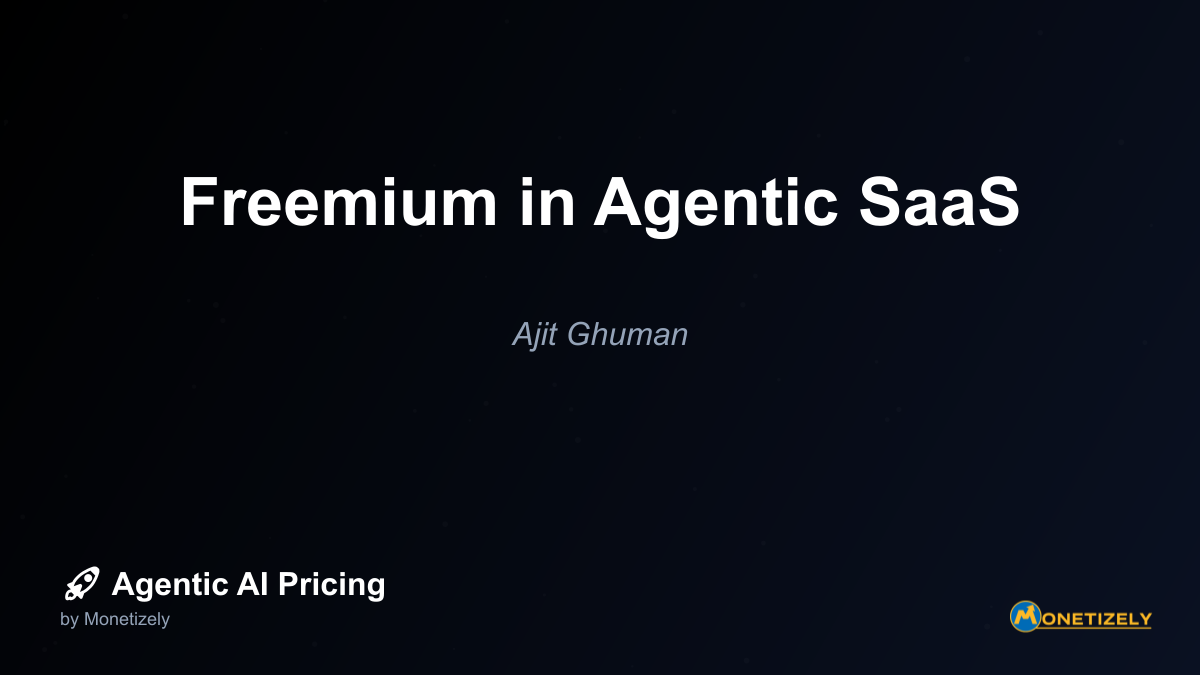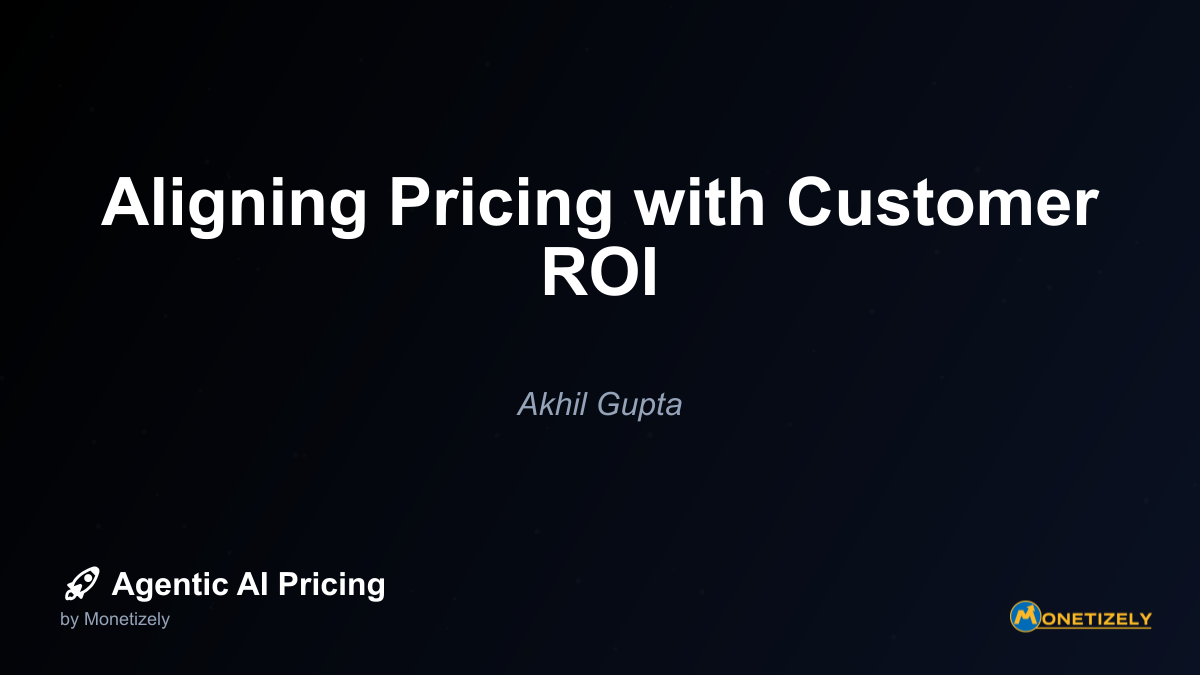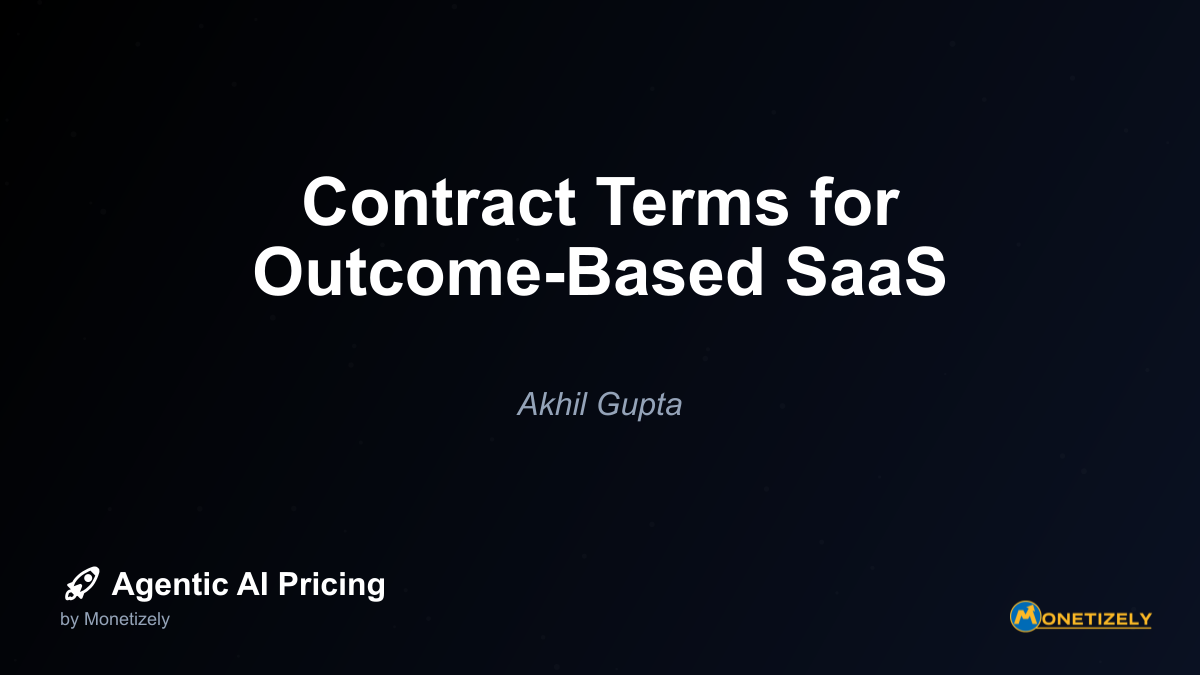· Ajit Ghuman · Pricing Agentic SaaS Products · 7 min read
Freemium in Agentic SaaS
AI and SaaS Pricing Masterclass
Learn the art of strategic pricing directly from industry experts. Our comprehensive course provides frameworks and methodologies for optimizing your pricing strategy in the evolving AI landscape. Earn a professional certification that can be imported directly to your LinkedIn profile.

3. Balance Value and Conversion Potential
The fundamental tension in freemium design is providing enough value to attract users while creating sufficient motivation to upgrade. For agentic AI, consider these balancing strategies:
The “Aha Moment” Approach: Design your free tier to deliver a clear “aha moment”—when users first experience the transformative potential of your agent. Then, create natural boundaries that emerge as usage increases.
The Capability Showcase: Allow free users to experience the full range of agent capabilities but in a limited context. For example, permit the agent to perform any task but only within one department or with a limited data set.
The Time-to-Value Accelerator: Structure your free tier to deliver quick wins that demonstrate immediate value, while reserving sustained, long-term value creation for paid tiers.
For agentic AI specifically, balancing the freemium model requires careful consideration of both user needs and business sustainability. The autonomous nature of these solutions means free users can potentially extract significant value without upgrading if limitations aren’t thoughtfully designed.
Optimizing Free-to-Paid Conversion Paths
Converting free users to paying customers requires strategic nurturing and well-timed conversion triggers:
1. Usage-Based Conversion Triggers
Monitor how users engage with your agentic solution and trigger conversion prompts at optimal moments:
- When users attempt to access premium capabilities
- After they’ve successfully completed a certain number of tasks
- When they reach usage limits during periods of high engagement
- When they attempt to expand the agent’s scope to new areas
These triggers should feel natural rather than arbitrary, helping users understand the value proposition of upgrading.
2. Educational Onboarding Sequences
Create guided experiences that help users understand the full potential of your agentic solution:
- Demonstrate basic capabilities in the first session
- Gradually introduce more complex use cases
- Highlight premium features contextually during relevant moments
- Provide case studies showing ROI for similar businesses
For agentic AI, education is particularly important as many users may not fully grasp the potential of autonomous capabilities without guidance.
3. Value Visualization Techniques
Help users quantify the value they’re receiving and could receive with a premium upgrade:
- Provide analytics showing time saved through automation
- Calculate potential ROI based on current usage patterns
- Visualize the “value gap” between current and potential usage
- Display benchmarks comparing their results to premium users
These visualizations make abstract benefits concrete, facilitating purchase decisions.
Measuring Freemium Success for Agentic AI
Traditional freemium metrics require adaptation for the agentic AI context:
Core Metrics to Track
Conversion Rate: Monitor the percentage of free users who convert to paid plans, segmented by:
- Use case
- Integration complexity
- Organization size
- Industry vertical
- Agent interaction frequency
Time-to-Conversion: Track how long it typically takes for users to convert from free to paid, and identify patterns that might accelerate this process.
Value Extraction Ratio: Measure the ratio of value delivered to free users versus paid users to ensure your free tier isn’t cannibalizing premium offerings.
Engagement Depth: Monitor how deeply users engage with your agent’s capabilities, as deeper engagement often correlates with higher conversion potential.
Expansion Patterns: Track how users attempt to expand their agent’s capabilities, as these expansion attempts represent natural conversion opportunities.
Agentic-Specific Indicators
Beyond traditional metrics, consider these agentic-specific indicators:
Autonomy Utilization: Measure how much users leverage autonomous capabilities versus manual oversight, as higher autonomy utilization often indicates readiness for premium features.
Workflow Integration Depth: Track how deeply users integrate the agent into their workflows, as deeper integration increases switching costs and conversion likelihood.
Decision Authority Delegation: Monitor how much decision-making authority users grant to the agent, as increased trust typically correlates with willingness to invest in premium capabilities.
Common Freemium Pitfalls in Agentic AI
Several common mistakes can undermine the effectiveness of freemium models for agentic AI:
1. The Generosity Trap
Offering too much value in the free tier is a common mistake, especially with agentic AI where autonomous capabilities can deliver substantial value even with limitations.
Signs you’ve fallen into the generosity trap:
- Free users stay free for extended periods without hitting limitations
- High satisfaction among free users without conversion pressure
- Limited feature differentiation between free and paid tiers
- Users can accomplish complete workflows without upgrading
Solution: Focus free tier limitations on scope and scale rather than core functionality. Allow users to experience the agent’s capabilities but limit where and how extensively they can be applied.
2. The Utility Deficit
Conversely, if your free tier doesn’t provide meaningful utility, users won’t experience enough value to consider upgrading.
Signs of a utility deficit:
- High abandonment rates during onboarding
- Low engagement among free users
- Limited feature exploration
- Negative feedback about free tier limitations
Solution: Ensure your free tier solves at least one complete problem effectively, demonstrating the agent’s potential while creating natural expansion opportunities.
3. The Complexity Barrier
Agentic AI solutions are inherently complex. If users struggle to understand and implement your free offering, they’re unlikely to convert.
Signs of a complexity barrier:
- Extended time-to-value for new users
- Low feature adoption rates
- High support requirements from free users
- Confusion about capability boundaries
Solution: Invest in intuitive onboarding, contextual guidance, and progressive complexity that grows with user sophistication.
Freemium Design Patterns for Agentic AI
Several proven design patterns have emerged for freemium agentic AI solutions:
The Capability Limiter Pattern
Structure:
- Full access to all agent capabilities
- Strict limitations on usage frequency or volume
- Premium tiers remove usage constraints
Best for: Solutions where users benefit from experiencing the full range of capabilities before committing.
The Autonomy Escalator Pattern
Structure:
- Free tier requires human approval for most agent actions
- Premium tiers progressively increase autonomous authority
- Enterprise tiers allow full autonomous operation within governance frameworks
Best for: Solutions where trust and confidence in the agent’s decision-making develop over time.
The Ecosystem Expander Pattern
Structure:
- Free tier allows full agent functionality within limited ecosystems
- Premium tiers expand the range of integrations and data sources
- Enterprise tiers enable cross-system orchestration
Best for: Solutions where value scales with integration breadth and depth.
The Specialization Unlocking Pattern
Structure:
- Free tier provides general-purpose capabilities
- Premium tiers unlock specialized functionality for specific use cases
- Enterprise tiers enable customizable specialization
Best for: Solutions serving multiple distinct use cases or industries.
Implementing Your Freemium Strategy
Successful implementation requires cross-functional alignment and continuous optimization:
1. Technical Implementation Considerations
Ensure your architecture supports clean separation between free and premium capabilities:
- Design for feature flagging and permission-based access
- Implement usage monitoring and limitation enforcement
- Create seamless upgrade paths that preserve existing configurations
- Build analytics capabilities to track conversion metrics
2. Marketing and Messaging Alignment
Align your marketing and in-product messaging to support the freemium strategy:
- Clearly communicate free tier capabilities and limitations
- Highlight premium features contextually during relevant user journeys
- Showcase success stories from users who have upgraded
- Emphasize ROI and value rather than features alone
3. Customer Success Integration
Leverage customer success interactions to support conversion:
- Train customer success teams to identify upgrade readiness signals
- Provide tools for demonstrating premium value during support interactions
- Create upgrade incentives for customer success managers
- Develop case studies featuring similar users who have upgraded
The Future of Freemium in Agentic AI
As agentic AI evolves, freemium models will continue to adapt:
Emerging Trends
Value-Based Limitations: Rather than arbitrary usage caps, future freemium models may limit value extraction directly, allowing unlimited usage until a certain value threshold is reached.
Outcome-Sharing Models: Hybrid approaches where free usage is unlimited, but the provider shares in the value created once it exceeds certain thresholds.
Community-Powered Tiers: Free tiers that leverage community contributions for training and improvement, with premium tiers offering proprietary enhancements.
Personalized Freemium Paths: AI-driven customization of free tier limitations based on individual user behavior and value potential.
Conclusion: Crafting Your Agentic Freemium Strategy
Designing an effective freemium model for agentic AI requires balancing accessibility with sustainable monetization. The autonomous nature of these solutions creates unique challenges and opportunities for freemium design.
The most successful approaches will:
- Demonstrate clear value through complete problem-solving in the free tier
- Create natural, logical boundaries that scale with user success
- Provide educational pathways that help users understand premium potential
- Measure and optimize based on agentic-specific indicators
- Continuously evolve as user needs and competitive landscapes change
As you develop your freemium strategy, remember that the goal isn’t merely to convert free users to paid customers but to create a sustainable ecosystem where users receive appropriate value at each tier. By thoughtfully designing your freemium approach, you can build a powerful customer acquisition engine while ensuring long-term business sustainability.
The unique capabilities of agentic AI—autonomy, learning, and adaptation—create unprecedented opportunities for value delivery. Your freemium model should reflect these unique characteristics, creating experiences that demonstrate transformative potential while establishing clear pathways to expanded value through premium offerings.
Co-Founder & CEO
Ajit is the author of Price To Scale, a top book on SaaS Pricing and is the Founder of Monetizely. Ajit has led and worked in pricing and product marketing at firms like Twilio, Narvar and Medallia. His work has been featured in Forbes and VentureBeat. Ajit regularly consults with software companies from Seed stage to post-IPO on pricing strategy. Ajit is also a highly-rated co-instructor for 'The Art of SaaS Pricing and Monetization' on Maven.
Pricing Strategy Audit
Let our experts analyze your current pricing strategy and identify opportunities for improvement. Our data-driven assessment will help you unlock untapped revenue potential and optimize your AI pricing approach.




